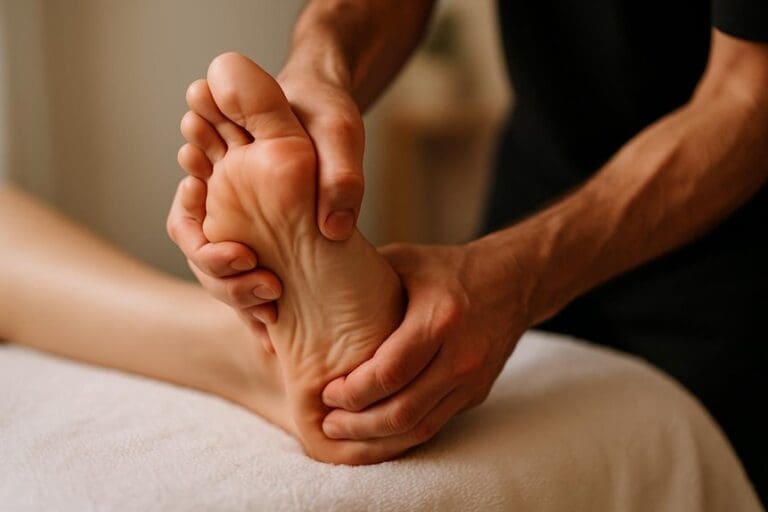Yes. This massage therapy can trigger bowel movements by shifting autonomic balance toward parasympathetic (vagal) dominance, slowing heart rate and boosting gut motility. Gentle, paced pressure, diaphragmatic release, and softening myofascial tension improve colonic mobility and circulation, sometimes provoking an urge to defecate, gurgling, or softer stools. Mild nausea or cramping can occur as peristalsis normalizes. Hydration, light movement, and breathing support comfort. Persistent severe symptoms warrant medical review. Practical steps, techniques, and aftercare can optimize digestive responses.
Why Massage Can Affect Your Digestive System

Although massage is applied to the musculoskeletal system, it can modulate digestive function through autonomic, mechanical, and circulatory mechanisms. Gentle, sustained pressure downregulates sympathetic tone and enhances vagal activity, which increases gastric motility and coordinated peristalsis.
Targeted work along the abdominal wall and lumbosacral fascia can soften myofascial tension that restricts the colon’s mobility, while diaphragmatic release improves intra-abdominal pressure gradients that guide transit. Improved perfusion—via vasodilation and lymphatic return—supports mucosal function and fluid balance within the bowel.
Spa & Massage therapists apply evidence-informed techniques with mindful pacing, encouraging slow breathing to amplify vagal effects. When indicated, they incorporate light abdominal effleurage and sacral holds, always respecting comfort and consent.
Many clients notice eased bloating, softer abdominal tone, and a steadier, more natural urge to pass stool. Similar mechanisms are discussed in the healing power of reflexology, where gentle manipulation of specific areas also promotes digestive health and overall bodily balance.
What Happens in a Deep Tissue Massage
This massage systematically addresses layers of fascia and muscle using slow, concentrated strokes, sustained pressure, and targeted friction to reduce adhesions and restore tissue glide. Skilled therapists at Spa & Massage first assess posture and palpate for trigger points, hypertonic bands, and restricted planes.
Pressure is applied along fiber orientation—often in the erector spinae, quadratus lumborum, gluteals, hamstrings, and calf complex—then cross-fiber friction refines local mobility. Breath cueing invites parasympathetic ease while maintaining therapeutic depth.
Lubrication is minimal to enhance grip on tissue; in our clinics, neutral, hypoallergenic oils support precise contact. Clients are guided to notice heat, tenderness, and gradual lengthening.
Post-session, our therapists recommend hydrating, gentle mobility, and attentive pacing to consolidate neuromuscular release and comfort.
The Gut–Nervous System Connection During Treatment
During deep tissue work, targeted pressure and diaphragmatic breathing can enhance vagus nerve signaling, modulating autonomic tone.
As the parasympathetic system predominates, heart rate and sympathetic arousal decrease, creating conditions that favor gastrointestinal activity.
Clinically, this shift may increase gut motility and urge for bowel movement, a response Spa & Massage therapists explain and monitor during sessions.
Vagus Nerve Activation
Gentle, sustained pressure along the back, neck, and abdomen can modulate vagal tone, linking musculoskeletal work to autonomic balance and gut motility. The vagus nerve carries parasympathetic fibers to the stomach, small intestine, and proximal colon; mechanical input through cervical paraspinals, suboccipital region, and the epigastric fascia may enhance afferent signaling, reducing sympathetic drive and supporting coordinated peristalsis.
In deep tissue sessions at Spa & Massage, therapists apply slow, patient strokes over the carotid sheath borders, thoracolumbar fascia, and diaphragm attachments, avoiding direct carotid compression while encouraging full, diaphragmatic breathing.
This careful pacing—pressure, release, breath—can increase heart rate variability, soften abdominal guarding, and normalise bowel transit. Clients are invited to communicate sensation thresholds; therapists then titrate depth to maintain comfort while promoting vagally mediated digestive ease.
Parasympathetic Shift Effects
Building on vagal engagement, the body’s shift toward parasympathetic dominance during deep tissue work alters gut function in measurable ways. As sympathetic tone recedes, acetylcholine-mediated signaling rises, lowering heart rate, softening diaphragmatic guard, and easing pelvic floor co-contraction.
This supports coordinated enteric activity, improved mucosal perfusion, and restoration of baseline visceral sensitivity.
At Spa & Massage, therapists cultivate this state with paced diaphragmatic cueing, unhurried stroke cadence, and sustained pressure that encourages baroreceptor and vagal afferent reassurance. Clients often notice warmth across the abdomen, a quieter breath, and a gentle urge to soften the belly—markers of autonomic settling rather than mere relaxation.
Gut Motility Responses
Although relaxation is often credited, the immediate drivers of bowel changes under deep tissue work are neurogastroenteric reflexes that modulate gut motility. Firm, sustained pressure near the thoracolumbar region and abdomen can stimulate vagal afferents and sacral parasympathetic outflow, adjusting peristaltic tone through the enteric nervous system.
Mechanoreceptor input influences the migrating motor complex, colonic mass movements, and sphincter relaxation, sometimes prompting an urge to defecate soon after treatment.
Spa & Massage therapists apply graded pressure and deliberate pacing to avoid overwhelming sympathetic responses that might inhibit transit. When indicated, they use gentle abdominal techniques and diaphragmatic breathing cues to enhance vagal drive while monitoring comfort.
Clients are advised to hydrate, allow time after sessions, and communicate gastrointestinal sensitivities so modulation of touch, tempo, and positioning can support predictable, respectful gut rhythms.
Common Digestive Reactions You Might Experience
A deep muscle therapy can influence gastrointestinal function through autonomic nervous system shifts and mechanical effects on the abdominal wall and lumbar fascia.
Following treatment, individuals may notice increased bowel motility, a softer, more urgent stool, or the passage of gas as enteric reflexes normalize. Mild abdominal gurgling (borborygmi) commonly reflects enhanced parasympathetic tone.
Some experience transient nausea if trigger points near the diaphragm or psoas are released, especially when combined with deep diaphragmatic breathing. Gentle abdominal fullness or cramping can appear as mesenteric circulation improves and peristalsis resumes.
Hydration status modulates these responses; dehydration may delay stool despite active motility. Rarely, sympathetic arousal from intense pressure can momentarily inhibit bowel activity.
At Spa & Massage, therapists observe these patterns and tailor depth and pacing to support comfortable, predictable digestion.
How We Support Comfortable Digestion at Spa & Massage
At Spa & Massage, therapists may incorporate gentle, clockwise abdominal techniques that follow colonic transit to reduce visceral tension and support peristaltic efficiency.
They pair this with clear aftercare hydration guidance, advising gradual water intake to optimise intestinal motility and stool consistency.
These measures are adapted to client comfort, medical history, and treatment goals across our London clinics.
Gentle Abdominal Techniques
While deep tissue work targets musculoskeletal tension, gentle abdominal techniques at Spa & Massage are applied with light, methodical pressure to support gastrointestinal motility and comfort. Therapists use clockwise strokes following colonic anatomy—ascending, transverse, and descending colon—paired with diaphragmatic release to modulate vagal tone and reduce visceral guarding.
Slow, sustained contacts over the iliac fossa and sigmoid region encourage peristaltic rhythm without provoking strain. Pressure is graded and always superficial to avoid compressing sensitive organs. Glide paths are warmed with neutral, hypoallergenic oil to maintain tactile clarity and patient ease. Breath-synchronized sequencing—exerting slight pressure on exhalation—invites parasympathetic settle, easing cramping and bloating.
Sessions integrate pelvic-floor softening and gentle lumbar decompression, harmonizing abdominal wall tone so digestion feels unforced, private, and deeply respected.
Aftercare Hydration Guidance
Because tissue manipulation and gentle abdominal work can transiently shift fluid distribution and vagal tone, Spa & Massage provides precise hydration guidance to stabilise circulation and support bowel motility post-session.
Therapists recommend 300–500 ml of water within 30 minutes, then steady sipping over the next 4–6 hours. This volume helps replenish intravascular fluid, dilute luminal contents, and facilitate peristalsis without provoking urgency.
Clients are advised to favour warm water or herbal infusions; warmth can relax esophageal and intestinal smooth muscle and reduce cramping.
Electrolyte balance matters: a light pinch of sodium and potassium from food or a low-sugar electrolyte drink may prevent post-treatment lightheadedness.
Alcohol and excess caffeine are discouraged.
Pair fluids with fibre-rich, easily digestible foods and a gentle walk to encourage colonic motility.
Tips to Prepare and What to Do After Your Session

A well-planned approach enhances the comfort and gastrointestinal benefits of deep muscle therapy. Spa & Massage advises arriving nourished yet light: a small meal 2–3 hours prior helps prevent vagal discomfort while supporting motility. Empty the bladder beforehand, and share bowel patterns, trigger foods, and abdominal sensitivities with the therapist to guide pressure along the colon’s anatomical course.
In our clinics, hypoallergenic oils and diaphragmatic breathing are used to modulate autonomic tone.
After the session, sip water steadily, then walk 10–15 minutes to stimulate peristalsis. If the urge to pass stool arises, do not delay. Choose a warm, fibre-inclusive meal, and avoid alcohol until baseline returns.
Gentle abdominal self-massage—clockwise from the right lower quadrant—can ease gas. Note responses in a journal for tailored future care.
When Digestive Changes May Signal Something Else
Though temporary shifts in bowel habits are common after deep tissue work, certain patterns warrant medical review rather than reassured watchful waiting.
Red flags include persistent diarrhea or constipation beyond 72 hours, visible blood or black, tarry stool, fever, severe cramping localized to the lower abdomen, vomiting, unintentional weight loss, or nocturnal symptoms that wake a person from sleep.
New bowel changes in adults over 50, or in anyone with a history of inflammatory bowel disease, should prompt timely assessment.
At Spa & Massage, therapists note and document gastrointestinal sensitivities and adapt pressure around the abdomen, iliopsoas, and lumbar fascia to minimise visceral provocation.
They encourage gentle hydration, gradual fiber intake, and rest.
If concerning signs appear, clients are advised to pause massage and seek medical evaluation before resuming care.
Conclusion
In the end, the body proves admirably literal: press the tissues designed to move, and things move. Therapeutic deep massage activates parasympathetic pathways, heightens vagal tone, and nudges peristalsis—so, yes, a restroom visit may follow improved circulation and fascial release. At Spa & Massage, clinicians normalize these outcomes, prioritize hydration, and guide paced breathing to modulate gut reflexes. Ironically, the pursuit of musculoskeletal relief may deliver gastrointestinal efficiency—an evidence-based reminder that systems are integrated, even when clients imagine them in compartments.



